Creating Community, Online and Off: 12 Questions with Lisa Bunker, MA in Library Science '01
iSCHOOL ALUMNI PROFILE
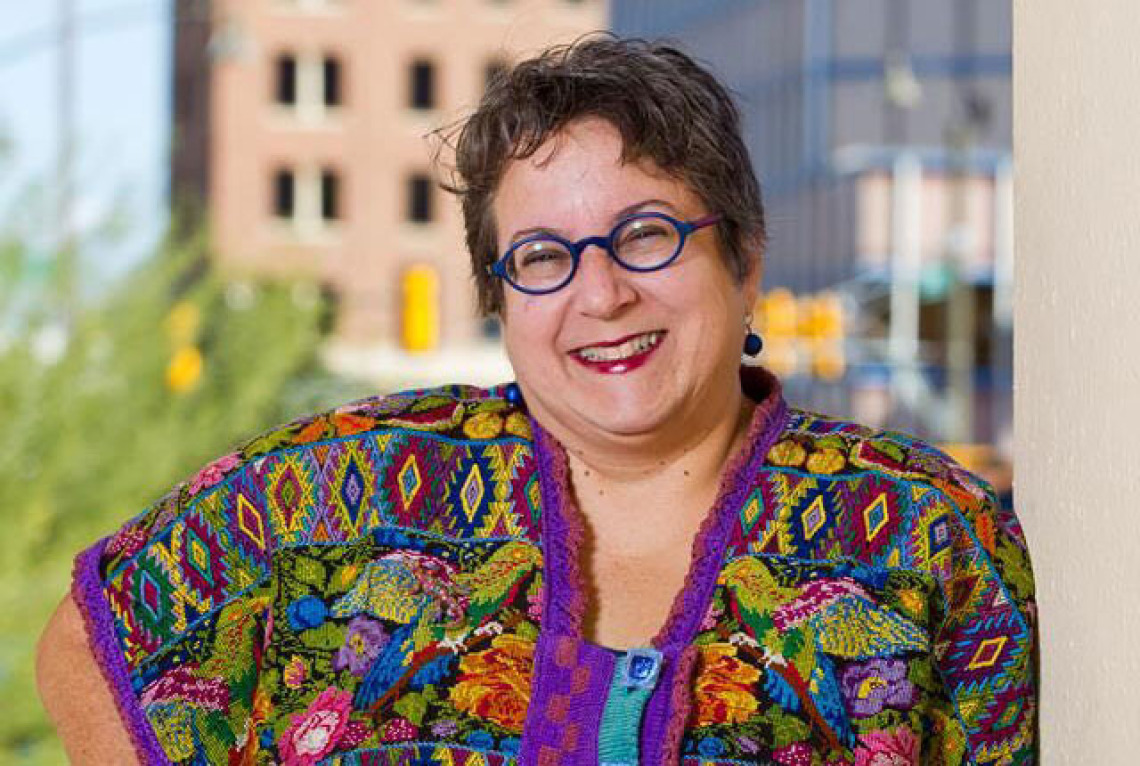
Lisa Bunker, retired social media librarian with Pima County Public Library. Photo by Dean Knuth.
Social Media Librarian (Retired), Pima County Public Library
I developed a strong conviction that libraries needed to figure out how to be relevant and create community in the newly forming online spaces. Not that our traditional focus on printed books was obsolete, but that we needed to figure out how to be just as relevant online. I carried this big picture goal throughout my career.
Lisa Bunker, who graduated from the UArizona Master of Arts in Library Science (now Master of Arts in Library and Information Science) in 2001, is a Tucson native who lived in many places before returning to work and study in Tucson. In this profile, she shares her fascinating experiences as a library science student, librarian at Pima County Public Library and, on her own time, "librarian in service to Harry Potter fandom."
What brought you to the University of Arizona to study library science?
My time working at the El Paso Public Library, from 1987 to 1992, convinced me that my career was in libraries, but we didn’t live in a place where a university offered a library sciences degree until we moved home to Tucson in 1999. All the same, I was apprehensive about starting another master’s degree since I had been forced to abandon an earlier art history degree due to extreme writer’s block. Seventeen years later I still feared that I couldn’t write well at an academic level or turn my papers in on time. I applied to the University of Arizona provisionally and didn’t formally apply until after I had turned my first paper in. On time. I decided that the degree was going to be my 40th birthday present to myself.
What was your focus area in the program?
By the time I applied in 1999, I had been working in library children’s services for 12 years. I loved this work; however, I decided to focus instead on archives or special collections work and finally put my art history undergraduate studies back into play.
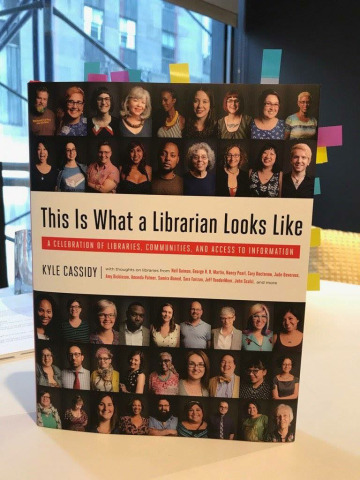
Lisa Bunker was profiled in the 2017 book by author and photograph Kyle Cassidy, This is What a Librarian Looks Like: A Celebration of Libraries, Communities and Access to Information.
What did you most enjoy about the Master's in Library Science program?
The MA in Library Science reawakened my love of archives and history and helped me see the mission of libraries in a broader historical and social context. It also helped me rebuild my confidence in myself and my ability to write well.
What did you most enjoy about your time at UArizona?
Graduate school was a time of huge growth for me, especially for my writing and communications skills. In 1999 the World Wide Web was still a little wild and wooly, and I talked my way into a job at the UArizona Library’s IT department because they would teach me to hand-code HTML. Website design and architecture were so powerful and magical to me that I started submitting my papers as webpages in addition to Word documents as assigned, just for practice.
Tell us about your library science final project.
As much as I loved the mission of public libraries, when I began my master’s degree I was determined to return to art libraries, archives or other museum libraries, so I made those needs the focus of my classes. In 2001 (my last year in the program), I was incredibly lucky to be chosen for an internship with the UArizona Libraries Special Collections, where I worked under Curator Bonnie Travers. She asked me to create an exhibit for the third-floor display area on the books the Nazis burned that were in the university’s collection.
I spent the semester horrified and appalled as I translated the original records online from the National Archives and books published in Germany. I located several of the existing “blacklists” and built the exhibit around the books, selecting books from our collection that were published before 1939. I wanted to show how similar in language and tone the Nazi documents were to the screeds of book banners today, so I asked Dr. Richter from the German Department to translate the accusations into English, and I included a display of the most frequently challenged books of 2001, including the language that was used to attack them.
Librarian Louise Greenfield helped me get in touch with Kurt Klein who, as a child, had witnessed the 1933 book burning in Heidelberg, and we were honored that he spoke at the opening. I also created a companion When Books Burn website, which, though is terribly dated design-wise, is still online.
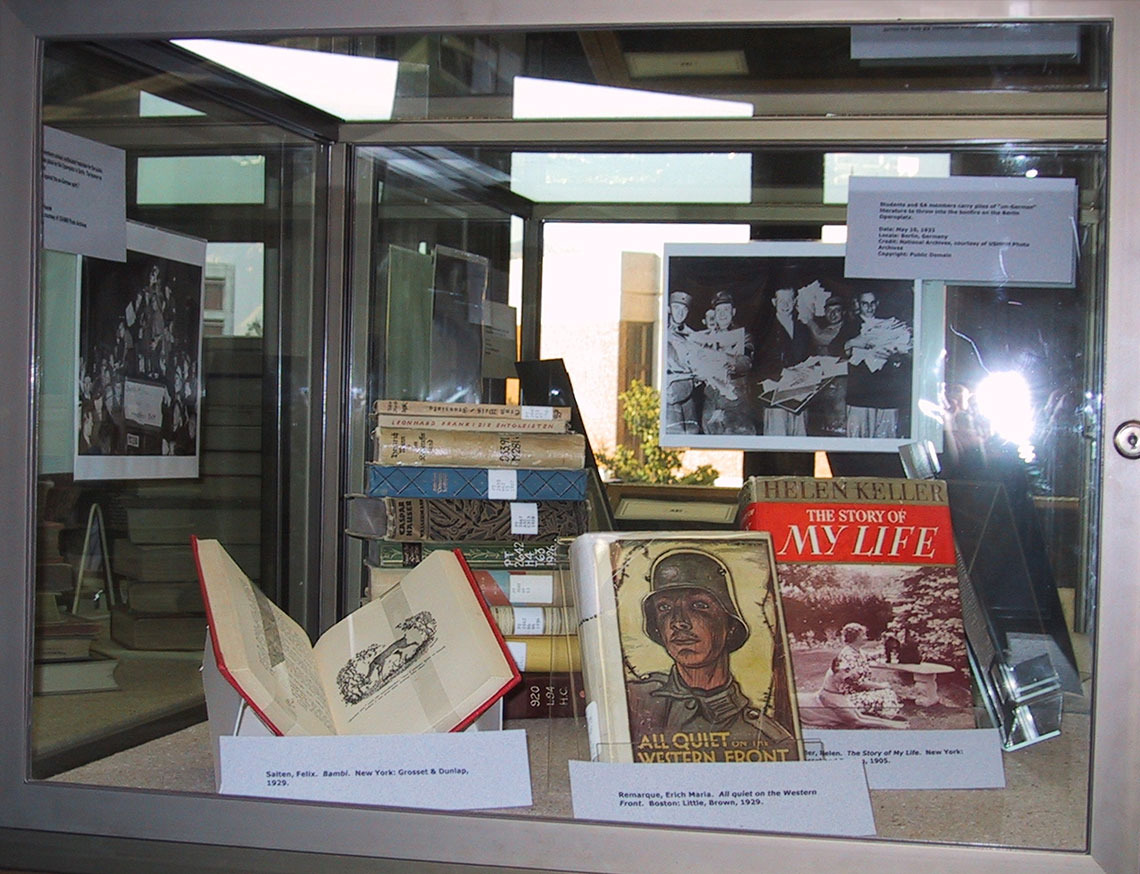
Lisa Bunker's final MA in Library Science project, a UArizona Libraries Special Collections display on the books Nazis burned that were in the university's collection. Photo by Lisa Bunker.
Walk us through your career path.
I’m retired now, but my last job was social media librarian for the Pima County Public Library.
The short version of my career path is that it took some strange twists and turns, all of which helped me to learn the skills I needed to become one of the first social media librarians in the country.
It’s funny: all of my job experience during my undergraduate years was in libraries, but I didn’t think of it as a career. Instead, my career goal was to work at a museum that had a collection focused on 19th-century art and the history of photography.
The reality was that my husband and I moved eight times in the first 12 years of our marriage, and I discovered that the library skills I had developed as a student worker were more useful than my degree in art history and museum studies. No matter where we lived I could find work I loved doing at public libraries and bookstores. From 1988 to 1999, I worked at well-funded libraries where I learned what could be done when a library isn’t constantly in survival mode, and I worked at poorly-funded libraries that were rich in compassion and connections to the neighborhoods they served.
In 1997, we moved home to Tucson and I ended up working at Sunrise Drive Elementary School’s library as the library assistant in charge of acquisitions and cataloging. I loved the job but was frustrated that I was still doing librarian-level work for $7.50 an hour. That’s when I decided to finally get my “library” degree at UArizona, beginning in 1999.
Unfortunately, I graduated during a deep economic recession, and all of the local libraries—public, private and academic—had been forced to freeze their hiring. For the next three years, I worked as a temporary librarian for the University of Arizona Library’s Social Sciences Team, where I designed and wrote online tutorials for a series of grant-funded projects. This was fascinating work, but I was relieved when the Tucson-Pima Public Library (now the Pima County Public Library) offered me permanent full-time work in 2004 as the children’s services librarian at the Eckstrom-Columbus Branch Library. In 2007, I moved to the Pima County Public Library’s Outreach Department, where I coordinated systemwide programs like the “First Card” campaign and co-taught literacy skills to women incarcerated at the Pima County Jail.
After two years in Outreach, I was surprised and delighted when Deputy Director Karyn Prechtel offered me a temporary, part-time position at the Tucson Museum of Art’s Library in 2009. Pima County Public Library’s Outreach Department was beginning to be reorganized and the Museum of Art needed a librarian to remain open and help retain their museum accreditation. The museum’s library, which is open to the public, had recently finished adding their incredible collection of books on art, art technique and art history to PCPL’s catalog, and our library leadership had an interest in helping the museum keep the doors open. Karyn knew of my art history training and research skills and had suggested me for the part-time job. Of course, I said yes. I would never have guessed that I would be working at an art museum library as an employee of a public library system, but that is what happened. I worked the other half of my hours on the Main Library’s reference team.
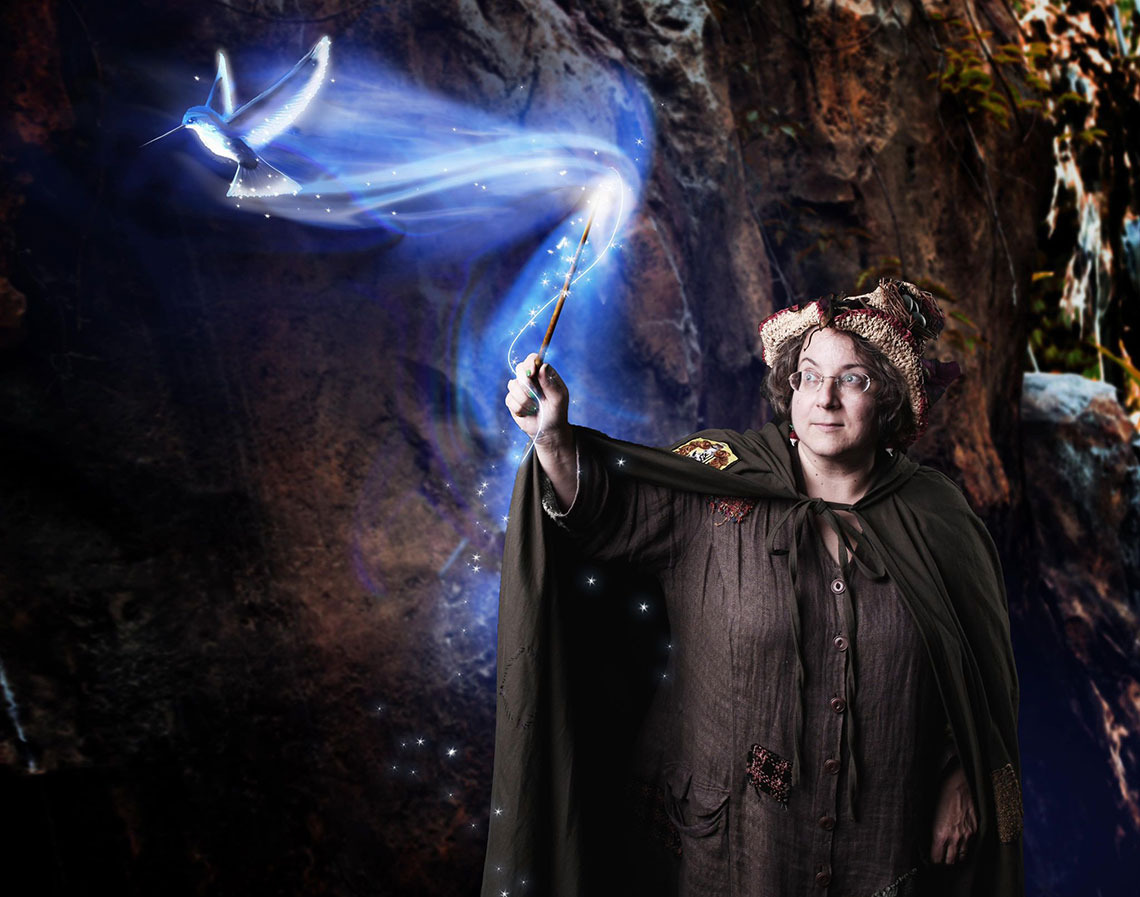
Lisa Bunker conjures up her hummingbird patronus. Photo courtesy Lisa Bunker.
There’s another weird twist to my career, but we need to back up a little bit. Basically, all this time, I had a second career at home as a librarian in service to Harry Potter fandom. I had always loved the books, but in 2004 I discovered the forums and websites that were the beginning of online Harry Potter fandom: especially Mugglenet, The Harry Potter Lexicon, The Leaky Cauldron, and HPANA fan forums. It was a wonderfully geeky mess of fanfics, costumes, crafts and theorizing. As a librarian, it was the theorizing that fascinated me.
Anyone who had read up to the third book in the series (Harry Potter and the Prisoner of Azkaban) or seen its 2004 movie, realized how author J.K. Rowling had been hiding clues to what would happen to Harry and the Wizarding World from the very beginning of the series. Forums like HPANA were full of young fans who were dissecting everything they could think of to see if they could predict what might happen as soon as every new book was published. Name derivations, etymology, rune and alchemical lore, symbolism, Latin translations, color and numerological symbolism… all this geekery made my frustrated art history librarian heart so happy.
Even more exciting, I recognized that Potter fandom was an opportunity to study how book-centric communities formed online with an eye to what libraries could learn for our own websites and social networking. What else could I do? I joined the fan forums and helped the much-younger fans figure out how and where to find authoritative sources for their theories. By 2006, my research materials for the fan forums had become full-fledged websites, and I ended up co-founding Accio Quote, an index to all of J.K. Rowling’s interviews. I also was a senior editor for The Harry Potter Lexicon, in charge of maintaining all of the site’s character pages.

Attendees as a Pima County Public Library Harry Potter party. Photo by Lisa Bunker.
In 2010, Jen Maney, the librarian in charge of Pima County Public Library’s website and digital materials, asked me use what I was learning from fandom and to take over the library system’s social media presence. We had just closed down our MySpace account and Jen wanted to see what I could do with the library’s Facebook pages and Twitter account.
It was a heady time. I was one of the first social media librarians in the country and amazingly was able to create policy and training materials from scratch, something very unusual in libraryland, where tradition and legacy policies are so strong. Most library social media was managed in a centralized way by a library’s marketing department. However, based on what I had learned from the Potterverse, Jen and I decided to find ways to capture the real-time energy of our front desks, and prioritize that over official marketing messaging. We developed a system where I would write for the primary library accounts, and then train frontline staff at branches for branch-level accounts. If a branch manager wanted to have a page on Facebook or a Twitter account, I trained the staff they assigned. Along with the dos and don’ts I asked them to write with the same informal helpfulness as they did at the desks, and to tell all the great stories that never made it into official press-releases. This trust was rarely broken, and over the years we have been able to tell a deeper story of what our libraries contribute to the communities of Pima County.
At the time, Pima County Public Library encouraged staff to go to conferences, and because social media was a huge part of South by Southwest in Austin, Texas, I attended the technology, music and pop culture conference, beginning in 2011. It was mind-blowing—primarily because I was fascinated by how powerful it was to have developers, entrepreneurs and nonprofits in the same room discussing solutions. When I returned I asked other Tucsonans who had gone to SXSW to do a “report back” about what they learned.
The SXSW “report” was successful, and gave me a programming idea that I eventually called Catalyst Café. I envisioned a series of informal discussions on tech and entrepreneurship topics that would be marketed to both businesses and nonprofits. Basically, I would call up local folks working on cutting-edge projects in the Tucson area and ask them to speak about what they were working on. Over the years we covered Kickstarter, the foodtruck biz, principles of lean startup, ways to gamify decision-making, online selling via Etsy, the legalities of social entrepreneurship and more.
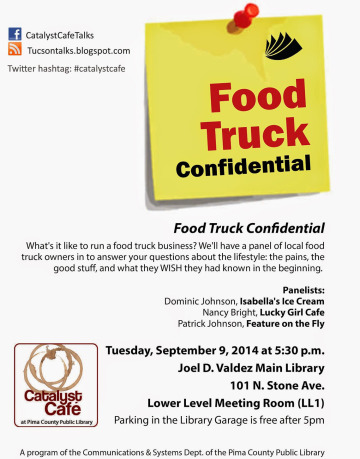
A flyer for one of many Catalyst Café events organized by Lisa Bunker at Pima County Public Library. Graphic courtesy Lisa Bunker.
My continuing participation at SXSW put me in touch with other librarians who were also focused on ways libraries could be experimental and innovative, especially staffers at the American Library Association. These connections meant I was invited to speak at national conferences about social media, the Catalyst Café and ways to plan for library innovation. I was also asked to contribute to Using Social Media to Build Library Communities: A LITA Guide.
COVID was an unexpected high-stakes test of the following we built on social media. With buildings shut down, staff on leave and no book circulation, our website activity plummeted. Our two best ways to maintain relationships and communicate service updates were either the email messages created by Holly Shaffer, or our social media pages
When I retired in 2021, almost every Pima County Public Library branch had an active Facebook page, and special services teams like Nuestras Raices and LGBTQ+ had either Facebook or Instagram accounts. On the whole, I believe that our de-centralized model for social media community building and communications has proven to be a strong one.
Select Presentations & Awards
As a librarian, Lisa Bunker participated in a wide array of presentations fostering innovation in librarianship, including:
- Social Media and Community Engagement panelist, Computers in Libraries, 2015
- Because Innovation is a Literacy, ALA Pre-session workshop with Brooke Shelton and Robin Breault, 2015
- Milk and Cookies with Strangers, ALA Conference Ignite Talk, 2015
- The Library as a Catalyst for Innovation: Case Studies of Library Entrepreneurship Centers and Programming, ALA Midwinter Master's Session, 2014
- LITA Top Tech Trends panelist, ALA Midwinter, 2014
- Potterize It: Sharing the Magic of Fan Culture, South by Southwest Interactive panelist, 2012
She was also named a Library Journal Mover and Shaker in the area of Library Technology in 2012.
How did your academic experience at the iSchool prepare you for your career as a librarian?
I took a class my last semester taught by Stu Glogoff, who was then an assistant dean at the UArizona Library. The class was focused on future-proofing American libraries, and the reading list was thought-provoking and inspiring. We read Bill Joy, Tim Berners-Lee, historians of library technology and more. I developed a strong conviction that libraries needed to figure out how to be relevant and create community in the newly forming online spaces. Not that our traditional focus on printed books was obsolete, but that we needed to figure out how to be just as relevant online. I carried this big picture goal throughout the rest of my career.
Given your experience in creating ongoing relevancy for libraries, what advice do you have for other library professionals given the rapid pace of technological change?
If you are ambitious and want to make a difference, pay attention to the forces that are disrupting libraries, human communications, services to the underserved and how we as a society form community. And then show up and contribute. Articulate to the people you meet about how libraries are changing, too, because this is almost always a surprise. Attend presentations and forward-thinking conferences, even ones that may be outside of traditional libraryland, and network with the other library colleagues you will meet. Do this, if possible, even if it is on your own time. And finally, bring back what you are learning to your local and national professional spaces
Disruption is threatening but it also creates opportunities; be the person who is there with knowledge of what is going on. When I began working in libraries we were still cataloging from scratch and filing cards in catalogs. When I began my Master’s in Library Science program, we were still being taught how to search the internet using clunky tools like Gopher, Archie and Veronica. Most libraries had no website. The career I had as a social media librarian didn’t exist a mere eight years earlier when I was at UArizona.
I don’t want to make it sound like there’s something wrong or lesser or unambitious about working within traditional library roles and finding your own place that is rewarding in ways that give you joy and a sense of purpose. You are the backbone of any library and the people who build and maintain your library’s community role as a place of learning, pleasure reading, acceptance and sanctuary. You are a crucial part of your community’s safety net, especially in the areas of literacy, job readiness, safety and people’s ability to retain a personal sense of wonder.
I also want to acknowledge that I climbed a career ladder that was structured for someone like me as a white CIS person of privilege. Any rough periods I experienced were due to my own particular struggles and not my background.
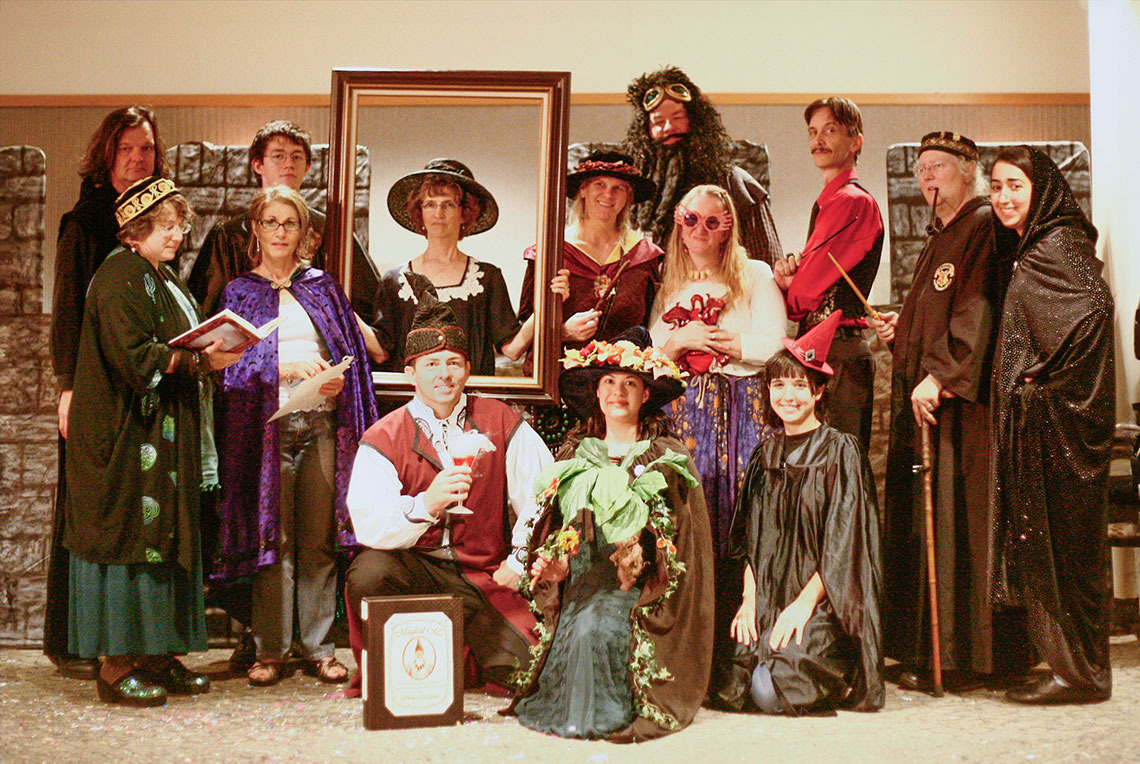
Lisa Bunker and other librarians and friends in costume for a Harry Potter event. Photo courtesy Lisa Bunker.
What have you found most unexpected in your work?
I think it was how my involvement in Harry Potter fandom (on my own time) eventually became interwoven with my work at the library. In addition to my job assignment for social media, which I credit to what I learned in fandom, I had the great joy of being part of the library team who put on elaborate Harry Potter parties at our libraries and at Hotel Congress.
Beyond your professional work, what are your passions?
From 1997 to around 2015, my passion was the vibrant, creative explosion and acceptance of other humans who live beyond societal norms that was Harry Potter fandom. I dove in with no reservations and met people all over the world who were more diverse in backgrounds, their creative responses to the books and especially gender identity. That this amazing community of adult fans has collapsed because of J.K. Rowling’s attacks on trans people has been profoundly disturbing for me.
Now that I am retired, I am exploring ways to spend my time and energy, but honestly, I am mostly just reading voraciously and working in my garden, something that is still partly a response to the way I changed during the COVID pandemic.
What is the best career advice you’ve received?
I think to be one of the people who have an eye on how and where libraries are changing and at the same time to be in touch with what is so very important about the traditional work we do for the people we serve.
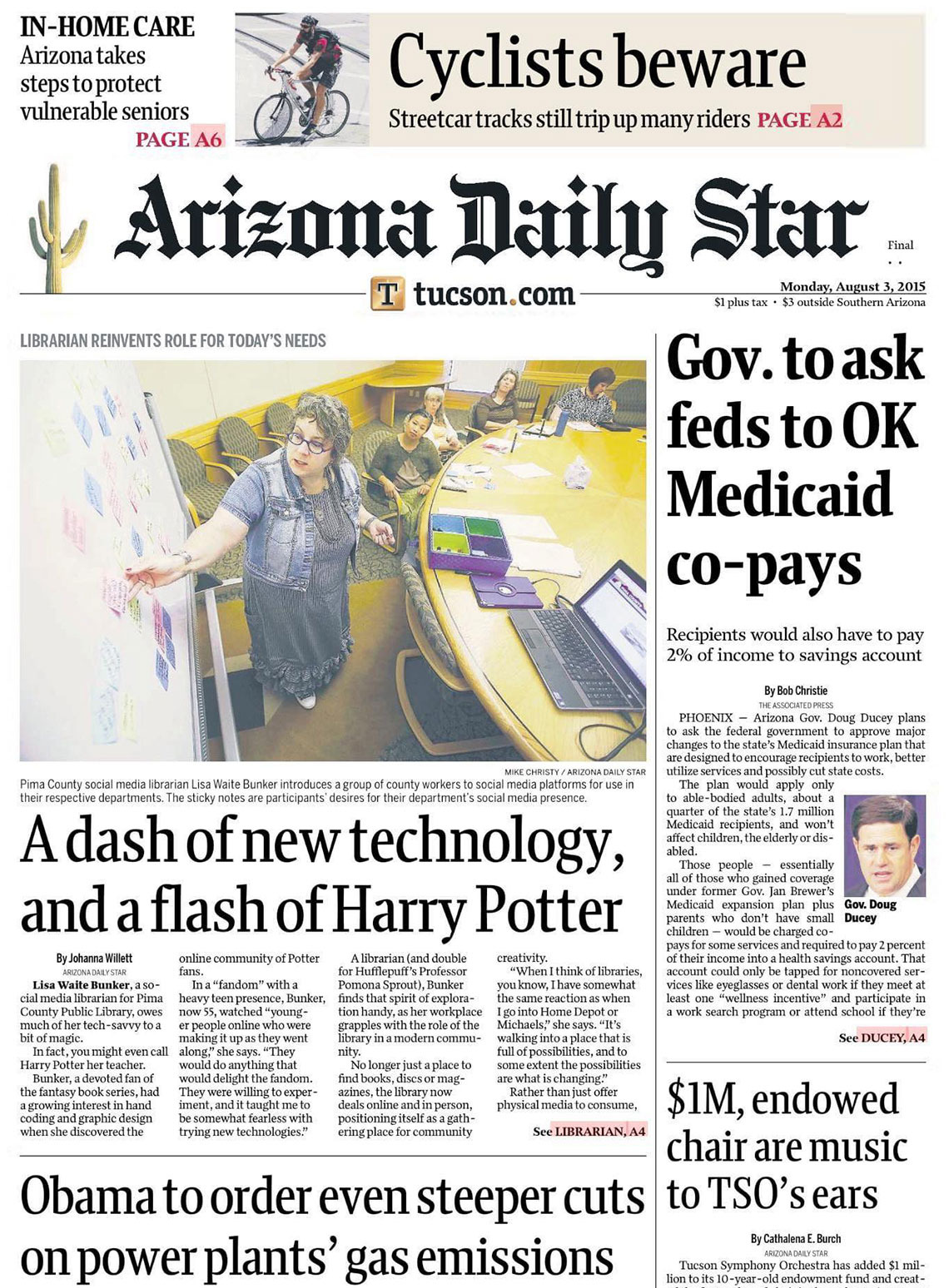
On the front page: Lisa Bunker's work is featured on the front page of the Arizona Daily Star (August 3, 2015): "A dash of new technology, and a flash of Harry Potter." The photo caption reads, "Pima County social media librarian Lisa Waite Bunker introduces a group of county workers to social media platforms for use in their respective departments. The sticky notes are participants' desires for their department's social media presence." Image courtesy Lisa Bunker.
What advice do you have for current or prospective iSchool students or those just entering the profession?
Explore, take chances, show up where you’re needed even if it is on your own time, and learn to learn from failure.
I shouldn’t downplay the fact that it is often difficult to be one of the staff members who is taking chances and advocating for adaptation and change. So take care of yourself, develop coping skills and learn to be in touch with your own wellbeing. You can’t be effective if your communication and consensus-building skills are weakened by your own personal health and ability to work with others. Work hard to remain humble and never forget how important it is to listen.
Learn more about the iSchool's MA in Library and Information Science, or explore ways you may support iSchool faculty and students who are driving the digital revolution.

